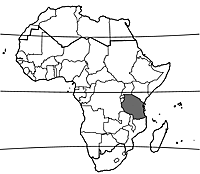Anisophyllea obtusifolia (PROTA)
Introduction |
| General importance | |
| Geographic coverage Africa | |
| Geographic coverage World | |
| Medicinal | |
| Timber | |
| Fuel | |
| Fibre | |
| Conservation status | |
Anisophyllea obtusifolia Engl. & Brehmer
- Protologue: Bot. Jahrb. Syst. 54: 372 (1917).
- Family: Anisophylleaceae
Vernacular names
- Msaa-mti (Sw).
Origin and geographic distribution
Anisophyllea obtusifolia is endemic to the Usambara Mountains in Tanzania.
Uses
The wood is used for building poles and tool handles. It is suitable for construction, flooring, ship building, furniture, cabinet work, toys, novelties, boxes and crates. It is also used as firewood and for charcoal production, and it is suitable as pulpwood. The twigs are used as toothbrush. The Washambaa people use the roots in traditional medicine to treat kidney complaints.
Properties
The heartwood is pale brown and not distinctly demarcated from the sapwood. The grain is straight, texture moderately coarse. Quarter-sawn surfaces show an oak-like silver grain. The wood is moderately heavy, with a density of 690–850 kg/m³ at 12% moisture content. It is difficult to air dry because it dries slowly and has a tendency to cup and split. Sometimes it is susceptible to severe degrade by case hardening and honeycombing. It takes about 8 months to air dry 5 cm thick boards from 77% to 15% moisture content. The rates of shrinkage are high, from green to air dry 3.5% radial and 10.4% tangential. Quarter-sawing is recommended before drying. The wood is easy to saw and work, but power demand is quite high. The wood takes a good finish. It is liable to splitting upon nailing, but holds nails well. The wood is not durable, about 1.5 years in contact with the ground, and is susceptible to Lyctus attack. The heartwood is resistant to impregnation by preservatives. The sawdust may cause allergic reactions to mucous membranes and skin.
Description
- Medium-sized to large tree up to 45 m tall; bole usually straight, branchless for up to 18 m, up to 90 cm in diameter; bark surface smooth to rough, pale grey to brown, inner bark granular, hard, reddish brown; twigs whitish or yellowish hairy.
- Leaves alternate, simple and entire; stipules absent; petiole very short; blade elliptical to narrowly elliptical, 0.5–7.5 cm × 0.5–3.5 cm, larger leaves alternating with smaller ones, cuneate to rounded at base, acute to slightly acuminate at apex, papery, glabrous, with 2–4 lateral veins curving up from near the base.
- Inflorescence a spike up to 4 cm long; bracts lanceolate, up to 6 mm long.
- Flowers functionally unisexual, rarely bisexual, regular, usually 4-merous, small, sessile; calyx with triangular-deltoid, erect lobes; petals free, 2–2.5 mm long, 3–5-lobed, lobes with coiled apices; stamens usually 8, free, glandular at base; ovary inferior, 4-celled, styles usually 4, fused at base; male flowers usually with sterile ovary, female flowers with sterile stamens.
- Fruit unknown.
Other botanical information
Anisophyllea comprises about 30 species and occurs in Africa, south-eastern Asia and South America. Based on molecular phylogenetics, the intercontinental disjunctions appear to date back about 22 million years and thus probably result from long-distance dispersal. Tropical Africa and Asia are richest in species, each nearly 15, and 2 species have been found in South America. In tropical Africa most Anisophyllea spp. are shrubs or small trees mainly known for their edible fruits. In tropical Asia the hard and durable wood of some Anisophyllea spp. is used for beams in house construction, interior finish, furniture, tool handles, fence posts, household implements and sliced veneer.
Ecology
Anisophyllea obtusifolia occurs in evergreen rainforest at about 900 m altitude. It is locally common.
Genetic resources
Anisophyllea obtusifolia has a very limited area of distribution and may easily become threatened by exploitation or habitat loss.
Prospects
Increased utilization of Anisophyllea obtusifolia in the future is not likely because of its small distribution area and difficulties in drying its wood. Locally it may remain of some importance, but its exploitation should be closely monitored to avoid genetic erosion.
Major references
- Anonymous, 1962. Anisophyllea obtusifolia (msaamti). Timbers of Tanganyika. Utilisation Section, Forest Division, Moshi, Tanzania. 2 pp.
- Bolza, E. & Keating, W.G., 1972. African timbers: the properties, uses and characteristics of 700 species. Division of Building Research, CSIRO, Melbourne, Australia. 710 pp.
- Lewis, J., 1956. Rhizophoraceae. In: Turrill, W.B. & Milne-Redhead, E. (Editors). Flora of Tropical East Africa. Crown Agents for Oversea Governments and Administrations, London, United Kingdom. 20 pp.
- Lovett, J.C., Ruffo, C.K., Gereau, R.E. & Taplin, J.R.D., 2007. Field guide to the moist forest trees of Tanzania. [Internet] Centre for Ecology Law and Policy, Environment Department, University of York, York, United Kingdom. http://celp.org.uk/ projects/ tzforeco/. December 2008.
Other references
- Ong, H.C., 1998. Anisophyllea R. Br. ex Sabine. In: Sosef, M.S.M., Hong, L.T. & Prawirohatmodjo, S. (Editors). Plant Resources of South-East Asia No 5(3). Timber trees: Lesser-known timbers. Backhuys Publishers, Leiden, Netherlands. pp. 69–71.
- Tobe, H. & Raven, P.H., 1988. Floral morphology and evolution in Anisophylleaceae. Botanical Journal of the Linnean Society 98(1): 1–25.
- Zhang, L.-B., Simmons, M.P. & Renner, S.S., 2007. A phylogeny of Anisophylleaceae based on six nuclear and plastid loci: ancient disjunctions and recent dispersal between South America, Africa, and Asia. Molecular Phylogenetics and Evolution 44: 1057–1067.
Author(s)
- R.H.M.J. Lemmens, PROTA Network Office Europe, Wageningen University, P.O. Box 341, 6700 AH Wageningen, Netherlands
Correct citation of this article
Lemmens, R.H.M.J., 2009. Anisophyllea obtusifolia Engl. & Brehmer. In: Lemmens, R.H.M.J., Louppe, D. & Oteng-Amoako, A.A. (Editors). PROTA (Plant Resources of Tropical Africa / Ressources végétales de l’Afrique tropicale), Wageningen, Netherlands. Accessed 31 March 2025.
- See the Prota4U database.

